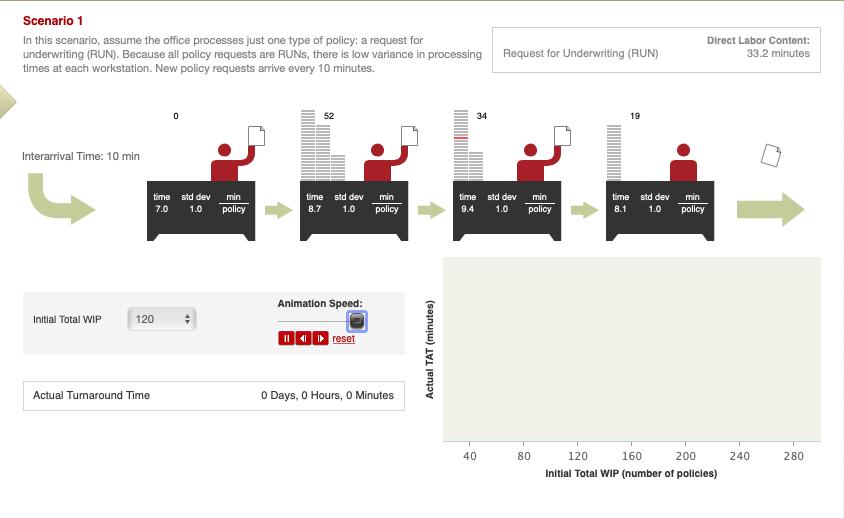Answered step by step
Verified Expert Solution
Question
1 Approved Answer
Scenario 1 In this scenario, assume the office processes just one type of policy: a request for underwriting (RUN). Because all policy requests are


Scenario 1 In this scenario, assume the office processes just one type of policy: a request for underwriting (RUN). Because all policy requests are RUNs, there is low variance in processing times at each workstation. New policy requests arrive every 10 minutes. Interarrival Time: 10 min Initial Total WIP 120 Actual Turnaround Time 0 time std dev min 7.0 1.0 policy 52 time std dev min 8.7 1.0 policy Animation Speed: 114 reset 0 Days, 0 Hours, 0 Minutes Actual TAT (minutes) 34 Request for Underwriting (RUN) min time std dev 9.4 1.0 policy 40 80 19 time std dev min 8.1 1.0 policy Direct Labor Content: 33.2 minutes 120 160 200 Initial Total WIP (number of policies) 240 280 Question 1 Question 2 Question 3 Run Scenario 1 with 40 policies in process (WIP = 40), 10 at each workstation. Watch the red policy as it goes through the system. What is the turnaround time (TAT) (round to the nearest hour)? What would the TAT be in Scenario 1 if there were 240 units in the system initially (round to the nearest hour)? Suppose you walk into a similar organization as Scenario 1 that has a 15-step process running at steady state. You count total WIP of 720 units and are told that the slowest workstation (bottleneck) has a task time of 5.0 minutes. What is your estimate of the turnaround time for the whole process, in hours?
Step by Step Solution
There are 3 Steps involved in it
Step: 1
How to Play Internival Time 10 min IT WIP Introduction time de 70 120 1 RUN 1 STEP RUN TO END 0 1 ...
Get Instant Access to Expert-Tailored Solutions
See step-by-step solutions with expert insights and AI powered tools for academic success
Step: 2

Step: 3

Ace Your Homework with AI
Get the answers you need in no time with our AI-driven, step-by-step assistance
Get Started


